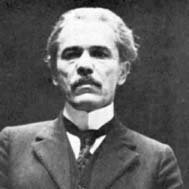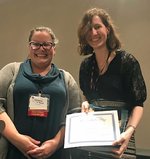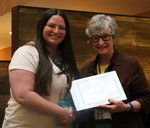The Ales Hrdlicka Prize

This prize was created in honor of Ales Hrdlicka (1869-1943). Dr. Hrdlicka was born in Humpolec, Bohemia (now the Czech Republic). In 1881 he immigrated with his family to the United States where he completed his secondary education and received a medical degree. Although he entered general practice for a short time, he soon became interested in the application of anthropometry to medicine and questions of population history. He eventually took an appointment in physical anthropology at the National Museum of Natural History in Washington, where he worked for the next forty years. At the National Museum he developed one of the finest collections of human osteological materials in the world. Although his interests were extremely broad, he focused much of his research on reconstructing the origins and population histories of Native American populations.
In 1918, Dr. Hrdlicka launched the American Journal of Physical Anthropology, a publication that he edited for the next twenty-four years of his life. Dr. Hrdlicka was the primary force behind the founding of the American Association of Physical Anthropologists in 1928, serving as its first president (1930-31) and chairing its first meeting in 1930 in Charlottesville, Virginia. Ales Hrdlicka died in Washington, D.C., on September 5, 1943.
Selected Works of Ales Hrdlicka
Hrdlicka A (1899) Anthropological investigations on one thousand white and colored children of both sexes, the inmates of the New York juvenile asylum, with additional notes on one hundred colored children of the New York colored asylum. New York.
Hrdlicka A (1904) Directions for collecting information and specimens for physical anthropology. Washington: Govt. print. off.
Hrdlicka A (1905) Brain weight in vertebrates. Washington, D.C.: Smithsonian Institution.
Hrdlicka A (1906a) Brains and brain preservatives. Washington: Government Printing Office.
Hrdlicka A (1906b) Contribution to the physical anthropology of California : based on collections in the Department of anthropology of the University of California and in the U.S. National museum. Berkeley: The University Press.
Hrdlicka A (1907) Skeletal remains suggesting or attributed to early man in North America. Washington: Govt. print. off.
Hrdlicka A (1908) Physiological and medical observations among the Indians of Southwestern United States and Northern Mexico. Washington: Govt Print Off.
Hrdlicka A (1909) Tuberculosis among certain Indian tribes of the United States. Washington: Govt. Print. Off.
Hrdlicka A (1910) Contribution to the anthropology of central and Smith sound Eskimo. New York: The Trustees.
Hrdlicka A (1911) Some results of recent anthropological exploration in Peru, with four plates. Washington: Smithsonian Institution.
Hrdlicka A (1912a) Medical and anthropological publications. [n.p.
Hrdlicka A (1912b) The natives of Kharga Oasis, Egypt. Washington: Smithsonian Institution.
Hrdlicka A (1912c) Remains in eastern Asia of the race that peopled America (with three plates). Washington: Smithsonian Institution.
Hrdlicka A (1914) Anthropological work in Peru, in 1913, with notes on the pathology of the ancient Peruvians, with twenty-six plates. Washington: Smithsonian Institution.
Hrdlicka A (1916a) The most ancient skeletal remains of man. Washington: Govt. Print. Off.
Hrdlicka A (1916b) Physical anthropology of the Lenape or Delawares, and of the eastern Indians in general. New York: The Museum of the American Indian, Heye foundation.
Hrdlicka A (1918) Recent discoveries attributed to early man in America. Washington: Govt. print. off.
Hrdlicka A (1919a) Physical anthropology; its scope and aims; its history and present status in the United States. Philadelphia: The Wistar institute of anatomy and biology.
Hrdlicka A (1919b) The races of Russia (with 1 map). Washington: Smithsonian Institution.
Hrdlicka A (1920) Anthropometry. Philadelphia: The Wistar institute of anatomy and biology.
Hrdlicka A (1922) The anthropology of Florida. Deland, Fla.: The Society.
Hrdlicka A (1924) Catalogue of human crania in the United States National Museum collections. Washington: Govt. Print. Off.
Hrdlicka A (1925a) The old Americans. Baltimore: The Williams & Wilkins Company.
Hrdlicka A (1925b) The origin and antiquity of the American Indian. Washington, D.C.: G.P.O.
Hrdlicka A (1927a) Anthropology of the American Negro : historical notes. [Philadelphia: Wistar Institute Press.
Hrdlicka A (1927b) The Neanderthal phase of man. London: Royal Anthropological Institute of Great Britain and Ireland.
Hrdlicka A (1929) Bibliography of Dr. Ales Hrdlicka [1892-1928]. Prague: Imp. V. & A. Janata, N. Bydzov.
Hrdlicka A (1930a) Anthropological survey in Alaska. Washington.
Hrdlicka A (1930b) The skeletal remains of early man. City of Washington: The Smithsonian institution.
Hrdlicka A (1931) Children who run on all fours, and other animal-like behaviors in the human child. New York: Whittlesey House, McGraw-Hill Book Company, inc.
Hrdlicka A (1934) The hypotrochanteric fossa of the femur (with 14 plates). City of Washington: The Smithsonian Institution.
Hrdlicka A (1935a) Ear exostoses (with five plates). City of Washington: The Smithsonian institution.
Hrdlicka A (1935b) Melanesians and Australians and the peopling of America. City of Washington: The Smithsonian institution.
Hrdlicka A (1937) Biographical memoir of George Sumner Huntington, 1861-1927. Washington: The National Academy of Sciences.
Hrdlicka A (1939) Practical anthropometry. Philadelphia: Wistar Institute of Anatomy and Biology.
Hrdlicka A (1940a) Observations and measurements on the members of the National academy of sciences. [Washington: U.S. Govt. print. off.
Hrdlicka A (1940b) Ritual ablation of front teeth in Siberia and America (with five plates). City of Washington: The Smithsonian institution.
Hrdlicka A (1941a) Diseases of and artifacts on skulls and bones from Kodiak island. City of Washington: The Smithsonian institution.
Hrdlicka A (1941b) Exploration of mummy caves in the Aleutian Islands. [Lancaster, Pa.: The Science Press.
Hrdlicka A (1942a) Catalog of human crania in the United States National Museum collections: Eskimo in general. Washington: Smithsonian Institution.
Hrdlicka A (1942b) The peoples of the Soviet Union. Washington: Smithsonian Institution.
Hrdlicka A (1943) Alaska diary, 1926-1931. Lancaster, Pa.: The Jaques Cattell press.
Hrdlicka A (1944a) The anthropology of Kodiak island. Philadelphia: The Wistar institute of anatomy and biology.
Hrdlicka A (1944b) Catalog of human crania in the United States National Museum collections. Non-Eskimo people of the northwest coast, Alaska, and Siberia. Washington, D.C.: Smithsonian Institution, United States National Museum.
Hrdlicka A (1970) Contribution to the physical anthropology of California. Berkeley: The University Press.
Hrdlicka A (1989) The Aleutian and Commander islands and their inhabitants. Philadelphia: Wistar Institute of Anatomy and Biology.
Hrdlicka A, Fenner CN, Wright FE, Holmes WH, and Willis B (1912) Early man in South America. Washington: G. P. O.
Hrdlicka A, Merbs CF, Christensen NR, Tyson RA, and Alcauskas ESD (1980) Catalogue of the Hrdlicka paleopathology collection. San Diego, Calif.: San Diego Museum of Man.
2019
 Julia Alyssa White, University of Oxford. From flesh to mesh: Bodies as maps in 3D GIS
Julia Alyssa White, University of Oxford. From flesh to mesh: Bodies as maps in 3D GIS
2018
 Ashley Edes, The Ohio State University. “Examining stress in western lowland gorillas: A multi-zoo application of the first allostatic load index in zoo-housed great apes”
Ashley Edes, The Ohio State University. “Examining stress in western lowland gorillas: A multi-zoo application of the first allostatic load index in zoo-housed great apes”
Sponsored prizes
2017
 Kristin Sabbi, University of New Mexico. “Attention to social grooming among immature East African chimpanzees (Pan troglodytes schweinfurthii) of the Kanyawara community at Kibale National Park”
Kristin Sabbi, University of New Mexico. “Attention to social grooming among immature East African chimpanzees (Pan troglodytes schweinfurthii) of the Kanyawara community at Kibale National Park”
Sponsored prizes
2016
Andrew Halley, University of California Berkeley. The embryonic origins of primate encephalization: allometric and growth analyses
2015
Eleanor Dove, Liverpool John Moores University. A (w)hole new idea: Using nutrient foramen location to identify relative growth and the center of ossification in juvenile tibiae
2014
Amy Baurenfeind, George Washington University. Differential gene and protein expression in the human and chimpanzee brain: A comparison using high-throughput techniques (with E.J. Soderblom, M.E. Turner, A.M. Moseley, J.J. Ely, P.R. Hof, C.C. Sherwood, G.A. Wray, and C.C. Babbitt)
2013
Julia Maki, Washington University. Skeletal estimates of upper limb effective mechanical advantage do not predict joint strength or speed in living humans
2012
Neil T. Roach, Harvard University. ‘‘Derived anatomy of the shoulder and wrist enable throwing ability in Homo.’’(with co-author DE Lieberman)
2011
Cara Ocobock, Washington University in St. Louis. ‘‘Daily energy expenditure in highly active humans in a natural temperate environment.’’
2010
Ellen Quillen, Pennsylvania State University. ‘‘Using Natural Selection to Identify Genes Determining Indigenous American Skin Pigmentation.’’
2009
Adam Foster, University of Arizona. Muscle force production during bent-knee, bent-hip walking in humans.
2008
Meghan M. Moran, Kent State University. ‘‘Walkers vs. non-walkers: a comparison of femoral neck cortical bone in humans.’’ (Coauthors: C.E. Hilton and B.G. Richmond.)
2007
Valerie Andrushko, University of California, Santa Barbara. ‘‘Strontium isotope evidence for prehistoric migration in the valley of Cuszco, Peru.’’ (Coauthors M.R. Buzon, A Sinometti and R.A. Creaser).
2006
Herman Pontzer, Harvard University. “The evolution of hominin locomotor performance and the emergence of Homo.”

